|
|
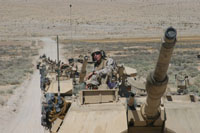 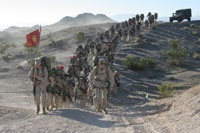
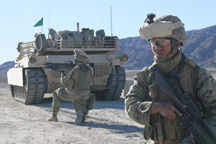
MCAGCC is the home of the Marine Corps’ Mojave Viper. Mojave Viper is a 30-day combination of the Revised Combined Arms Exercises and the Security and Stability Operations training formerly conducted at March Air Reserve Base, Calif. The RCAX program has evolved from a 22-day deployment with a very structured three-day CAX final exercise, into a 14-day intense training cycle involving a series of progressive live-fire exercises. The current RCAX program employs a progressive training approach, starting with combined-arms integration techniques and procedures at the company level and fire and movement/maneuver at the platoon level that culminates in the integration of large-scale maneuver with direct, indirect and aviation fires involving all elements of the exercise force. The SASO program has evolved from a Marine Corps Warfighting Lab experiment into a 10-day training exercise. The units are presented with facilities, role players and scenarios that closely replicate the environment to which they will deploy. The current SASO program employs a progressive training approach, starting with a series of lane-training opportunities at the squad through company level culminating in a three-day, battalion-level final exercise. Mojave Viper exercises and trains active duty and Reserve Fleet Marine Force units and Marine Air Ground Task Forces in command, control and coordination of kinetic and non-kinetic fires in the “Three Block War.” Mojave Viper is the most realistic, live-fire training exercise in the Marine Corps. It provides the commanders the opportunity to employ all the capabilities of the MAGTF. Approximately 2,000 Marines and Sailors participate in each training cycle which uses the “building block” approach, starting with small-unit training and culminating with MAGTF integration.
For the first week to 10 days of the deployment, training focuses on “white-space” training to integrate new personnel, complete basic training requirements and prepare for the SASO and RCAX sections. The next 10 days of Mojave Viper start with the unit doing a notional relief in place
in the Forward Operating Base from which they will operate for the remainder of the exercise. Squad and platoon rotations covering urban patrolling, improvised explosive device training, tank and infantry integration and various other skills necessary for operations in an urban environment follow this. During this time the companies operate in separate FOBs and conduct small-level operations. Concurrent with this is battalion staff training. The final exercise integrates the small unit and staff skills into a three-day, 24-hour-a-day, battalion-level operation.
The remaining 10 to 14 days focuses on combined-arms training. This training focuses on two levels. The staff refines tactical plans in the Combined Arms Staff Trainer then executes these plans in the air support coordination and fire support coordination exercises. Simultaneously, the platoons and companies conduct a series of infantry attacks. The culmination of company-level training includes one of the following exercises. The first is the Light Armored Reconnaissance Screen Course in which the LAR company conducts a delaying action along a 10-kilometer long course. The second is the Mobile Assault Course in which the unit conducts a deliberate attack along a 20-kilometer long course. The third is the Helicopter Assault Course in which the unit conducts a deliberate helicopterborne attack. Mortars, artillery, attack helicopters, fighter/attack aircraft and engineers support all of these courses. The live-fire Convoy Operations Course integrates Rotary-Wing Close Air Support, heavy machineguns and small arms into a 20-kilometer route with multiple engagements of increasing difficulty to prepare Combat Service Support Elements. This work-up period allows implementation of lessons learned in command, control and coordination, and for commanders at all levels to conduct any desired supplemental or specialized training.
The logistical challenges presented by operating throughout the Twentynine Palms environment are demanding. Food, water, fuel, ammunition, spare parts and maintenance support are in constant demand, while real and simulated casualties, both personnel and equipment, require evacuation to the rear.
Mojave Viper will eventually fully integrate “white-space,” SASO and RCAX that will have the exercise force simultaneously conducting all aspects of the “Three Block War” for the entire 30 days.
ESD manages, maintains, and repairs, over 9,500 Major End Items to include communications, engineer, motor transportation, and ordnance equipment. This equipment, which is maintained in the Enhanced Equipment Allowance Pool, is issued to units participating in Mojave Viper
pre-deployment training exercises in a safe and ready to use condition. ESD also maintains tactical equipment for the Tactical Training Exercise Control Group and the Advisor Training Group.
ESB Camp Wilson, maintained by the Facilities Management Division, is the rear area for the MAGTF participating in a CAX. ESB provides billeting, comfort, messing and recreational facilities, to include an exchange, a Warriors Club, a fitness center and phone center for more than 3,000 Marines. Additionally, the Combat Service Support Detachment provides pertinent services including the Field Ammunition Supply Point, Fuel Farm and the Hazardous Waste Accumulation site.
VMU-1 -"The Watchdogs”- operates and maintains unmanned aerial vehicle systems to provide unmanned aerial reconnaissance support to the MAGTF. The unit currently flies the Shadow UAV and provides ground commanders with flexible, on-call intelligence support. These remotely piloted UAVs carry electro-optic and infrared cameras that provide high-quality imagery both day and night. The unit is the primary test bed for new UAVs in the Marine Corps, and its Marines are actively involved in the operational testing and evaluation of the next generation of UAVs.
A tenant organization, VMU-1 is a subordinate squadron of Marine Aircraft Control Group 38, 3rd Marine Aircraft Wing, which is home-based at Marine Corps Air Station Miramar, Calif.
VMU-1 conducts flight operations at the Expeditionary Airfield. VMU-1 Marines frequently deploy to support operations and exercises throughout the world as well as in the United States.
The 7th Marine Regiment (Rein) - “The Magnificent 7th”- conducts mechanized, combined-arms operations and other expeditionary operations to support theater engagement plans and contingency operations. The regiment can deploy within 48 hours of receiving an execute order. The regiment also prepares infantry battalions to support I Marine Expeditionary Force operations and training.
The 7th Marine Regiment was formed at Philadelphia on Aug. 14, 1917, and served during both World Wars. The 7th deployed to Cuba in World War One. During World War Two, the unit saw action in the Solomon Islands, Eastern New Guinea, New Britain, bloody Peleliu and the island fortress of Okinawa, Japan. After the war, the regiment occupied China and disarmed Japanese troops in that country while maintaining peace in country torn by civil war.
The regiment landed Sept. 21, 1950, as part of the 1st Marine Division to stem the North Korean tide at Inchon, South Korea, and remained in-country until the armistice. The regiment next saw action in Vietnam in 1965 until the United States pulled out in September 1970. In August 1990, the 7th deployed to Saudi Arabia and participated in operations Desert Shield and Desert Storm where they manned the infamous “line in the sand.”
Shortly after returning to MCAGCC, the unit was redesignated as Regimental Combat Team 7 and participated in Operation Restore Hope in Somalia. Upon returning from Somalia, the regiment changed its name to the 7th Marine Regiment (Rein).
In January 2003, the president called upon the Marines to remove Saddam Hussein from power, and the Commandant of the Marine Corps
called on the Magnificent 7th. Deploying to Kuwait, the 7th Marines crossed the line of departure on March 20, 2003. A long 28 days later, in
what has been recognized as the furthest that Marines have ever penetrated inland, the president declared an end to hostilities as the dictator’s regime crumbled.
As a dedicated forward armed reconnaissance unit for 1st Marine Division, the 3d LAR performs forward reconnaissance, offensive, defensive and security missions in support of the MAGTF. Equipped with six mission-role variant, light armored vehicles and organic reconnaissance infantrymen, the battalion is uniquely organized to fight and acquire information, reaction time and needed maneuver space for the MAGTF commander to establish combat conditions favorable to his force’s success. In addition to its primary missions, the battalion serves the MAGTF commander as a flexible rapid reaction force and a versatile economy-of-force unit. With increased firepower and enhanced mobility, 3d LAR has an unmatched balance of lethality and survivability on the modern battlefield. A versatile combat unit, 3d LAR is well prepared to lead the 1st Marine Division in to the fight. Marines from the 3rd LAR rescued 10 Army hostages during Operation Iraqi Freedom.
3/11 is a proud MAGTFTC representative of both field artillery and the 11th Marine Regiment. The thundering roar of their 155mm howitzers echoing across the desert readily evidences their presence in the field. Through habitual relationship, 3/11 provides direct support artillery to the 7th Marine Regiment (Rein). As the only artillery unit aboard the base, the battalion stays busy throughout the year supporting numerous training evolutions including Steel Knight, 11th Marine Regimental Desert Firing Exercises and the Combined Arms Exercise program. 3/11’s howitzers were heard all across another desert during Operation Iraqi Freedom as they provided artillery support to the thousands of U.S. service members in that war.
1st Tank Battalion was activated November 1, 1941, at Marine Corps Base Camp Lejeune, North Carolina. The battalion saw combat in Pelieliu, Saipan, Okinawa, Korea, Vietnam, Southwest Asia, Kuwait and Iraq. It is the 1st Marine Division’s heavy punch. The mission of the 1st Tank Battalion is to provide combat power to the division in the form of amphibious and/or maritime preposition forces; conduct operations ashore utilizing maneuver, armor protected firepower and shock action in order to close with and destroy the enemy. The battalion is comprised of one Headquarters and Service Company four line companies, one Scout platoon and one AT(TOW) platoon. The battalion supports each Mojave Viper, provides a company to Operation Iraqi Freedom, the AT(TOW) platoon or Scout platoon to Operation Iraqi Freedom and provides a reinforced tank platoon to each Southern California Marine Expeditionary Unit Battalion Landing Team.
Along with the MEU and Mojave Viper support, First Tank Battalion participates in Exercise Summer Heat, Tank Table Gunnery (local qualification), Military Operations in Urban Terrain/Amphibious operations, Steel Knight, overseas exercises such as Foal Eagle, and the Marine Corps-wide annual HOTSHOT competition at Fort Knox, KY.
This expertise came in handy during Operation Iraqi Freedom as the battalion pounded Iraqi armor into submission.
In July 1979, two platoons of assault amphibian vehicles from Camp Pendleton arrived at the Combat Center to provide support in the form of mechanized transportation for CAX units. The two platoons were assigned to Companies A and B, 3rd Tank Battalion. The two platoons were combined in September of 1980 to form Company D, 3rd Tank Battalion. Two additional platoons from Hawaii arrived at the Combat Center on Dec. 22, 1981. In January of 1982, the company was redesignated as Company D (Rein), 3d Assault Amphibian Battalion. The company continues to support the CAX program as well as participate in mechanized exercises as part of the 27th Marines and the 7th Marine Expeditionary Brigade. In August of 1990, Company D deployed to Saudi Arabia for Operation Desert Shield. Company D was the first
assault amphibian unit declared combat ready and was in direct support of 1st Battalion, 7th Marines and 3rd Tank Battalion for the duration
of Operations Desert Shield and Desert Storm. Company D was part of the spearhead that attacked into Kuwait as part of Task Force Ripper.
In December of 1992, Company D deployed to Somalia to support Operation Restore Hope. During August of 1996, Company “D” transitioned from being attached to 7th Marine Regiment (rein) back to 3d Assault Amphibian Battalion. In February 2003, Company D deployed to Kuwait in support of Operation Iraqi Freedom.
MWSS-374 (rein) is permanently located aboard the Combat Center. MWSS’s mission is to support and maintain the Strategic Expeditionary Landing Facility and outlying facilities aboard the Combat Center. Additionally, MWSS-374 provides essential aviation ground support to the Aviation Combat Element during Exercise Mojave Viper.
The SELF is the largest expeditionary airfield operated by the Marine Corps. The runway is 8,000 feet by 150 feet and can accommodate the largest aircraft in the military inventory--the C-5 Galaxy and C-17 Globemaster. The runways, taxiways and aircraft parking areas are constructed entirely of AM-2 aluminum matting.
The SELF is a full-service airfield providing essential services required for flight operations in an austere expeditionary environment. In a normal year, MWSS Marines operate the SELF 300 days, conduct 3,600 hours of flight operations, support 16,647 aircraft, and pump more than five million gallons of jet fuel.
Beginning as the pigeon and flag handler platoon in 1932, the Marine Corps Communication-Electronics School was originally activated as Signal School, Signal Battalion, on Oct. 5, 1942 at Quantico, Va. The school moved to Camp Lejeune, N.C., in 1943, where it remained throughout World War II training radio operators, field wiremen and switchboard operators for combat operations in the Pacific. The school eventually offered 15 courses in the communications field.
In August 1946, the Signal School, Signal Battalion, relocated to Camp Del Mar, Camp Pendleton, where it continued training communications personnel, but in vastly reduced numbers.
In December 1949, the unit was redesignated as the Signal and Tracked Vehicle School Battalion. In 1950, the battalion moved to Marine Corps Recruit Depot, San Diego, remaining there for two decades. With the outbreak of hostilities in Korea, the school underwent provisional expansion to meet the urgent needs for training communications personnel for combat. The school was redesignated in September 1950 as Signal School Battalion.
Subsequent to the Korean Conflict, the school expanded its role to include training technicians and repairmen on the maintenance of the new and sophisticated electronics equipment being acquired by the Marine Corps, including the highly complex Marine Tactical Data System and its associated radar.
It was again redesignated in 1953 and became Communication-Electronics School Battalion, a title which was used until it was changed in February 1971 to what it is now: the Marine Corps Communication-Electronics School.
During the Vietnam Conflict, the school again expanded with more than 5,000 Marines being trained annually to meet the needs of combat forces in Southeast Asia. Included in the expansion was the establishment of a formal school designed to train officers in both air defense and air support skills.
In 1967, MCCES began to relocate from MCRD, San Diego, by moving Charlie and Echo companies to Marine Corps Base, Twentynine Palms. Delta and Alpha companies were moved in 1971, and finally, Bravo Company’s relocation in 1975 completed the move of the largest formal school in the Marine Corps. In 1998, MCCES expanded its horizons by incorporating the Computer Sciences School, relocated from Quantico, Va. In 2003 the Communication-Electronics Operator School and the Computer Sciences Schools were combined to create the Tactical Communications Training School.
MCCES trains personnel in the fields of operational communications, communications-electronics maintenance, air control, anti-air warfare operations, and information technology. Instructional programs within the school vary in length from two to 50 weeks. The school graduates approximately 5,000 Marine students annually. With a daily student load averaging over 1,100 students, the school conducts 48 separate courses of instruction for 38 different MOSs. There are 360 separate, scheduled classes conducted annually representing more than 120,000 hours of classroom instruction. To accomplish this training, MCCES is comprised of three training Companies: Communication-Electronics Maintenance School, Tactical Communication Training School, and Air School.
The school complex contains some of the most modern instructional facilities in the Marine Corps. It is a leader in developing and applying new and innovative instructional techniques in the automated facilitation of training delivery, testing, and evaluation. In executing its primary mission, the school graduates highly skilled and motivated operators, repairers, technicians, supervisors, planners, and managers of communication and electronics.
Over the year the Communications-Electronics School has played a vital role in the readiness of our Corps and our nation. Recognition in the form of unit awards includes the American Campaign Streamer, World War II Victory Streamer, National Defense Service Streamer with three bronze stars, the Global War on Terrorism Support Streamer, and the Meritorious Unit Commendation with three bronze stars.
The school has evolved from a modest beginning of training pigeon and flag handlers, to training Marines in the operation and maintenance of the most modern and sophisticated communication and electronic equipment in existence.
The Marine Corps Communication-Electronics School is proud to declare its motto as its mission, “We Train C4 Warriors.”
CLB-7, formerly known as Combat Service Support Group 1 and Combat Service Support Battalion-10, is part of the 1st Force Service Support Group and is permanently assigned to the Combat Center. Originally activated in 1976, its mission is to provide direct combat service support to RCT-7 during combat operations, and intermediate maintenance and supply support to Twentynine Palms based I MEF units. It also provides general support to Combat Service Support Detachments during Combined Arms Exercises, to the Combat Center’s Exercises and to the
Combat Center’s Exercise Support Division. Support includes provision of personnel administrative support for all units aboard the Combat Center. Unit awards include the Presidential Unit Citation (Operation Iraqi Freedom), Navy Unit Commendation (Southwest Asia Service), Meritorious Unit Commendation, and the National Defense Service Medal. CLB-7 provided support to the 7th Marine Regiment during Operation Iraqi Freedom I and II.
Headquarters Battalion provides battalion-level command, administrative support and individual training oversight to the Marines and Sailors who serve in the Directorates at Twentynine Palms, under the Commanding General, MAGTFTC/MCAGCC.
TTECG is the key coordinator and controller for CAX. They plan and safely orchestrate the exercises, requiring the exercise force to exercise
and integrate all of the capabilities resident in the MAGTF in accordance with existing Marine Corps warfighting doctrine. TTECG works closely
with Training and Education Command, MCCDC, Quantico, Va., as well as with the units participating in CAX, to ensure exercises simultaneously meet Marine Corps- and unit-specific training objectives. The TTECG “Coyotes” provide preliminary classroom introduction, control the actual exercise scenario in the field and portray the enemy actions to the exercise force in the scenario development. They also provide the essential safety backdrop, allowing exercise force units to employ the full spectrum of combat capabilities within the Marine Corps in the most permissive
of live-fire environments without any artificial control measures.
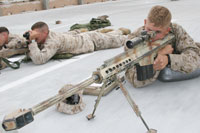 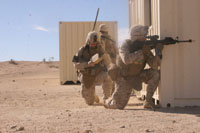 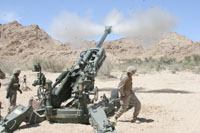
The Twentynine Palms Installation Guide is published by Benchmark Publications Incorporated, a private firm in no way connected with the U.S. Marine Corps, under exclusive written contract with the Marine Corps Air Ground Combat Center, Twentynine Palms. The appearance of advertising in this publication, including inserts and supplements, does not constitute endorsement by the U.S. Marine Corps or Benchmark Publications Incorporated of the products or services advertised. Everything advertised in this publication shall be made available for purchase, use or patronage without regarded to race, color, religion, sex, national origin, age, marital status, physical handicap, political affiliation or any other non-merit factor other purchaser, user or patron.
If a violation or rejection of this equal opportunity policy by an advertiser is confirmed, the publisher shall refuse to print advertising from that source until the violation is corrected. The Twentynine Palms Guide is an unofficial publication authorized by AR 360-1. Editorial content is prepared, edited and provided by the Public Affairs Office of MCAGCC, Twentynine Palms.
|
|